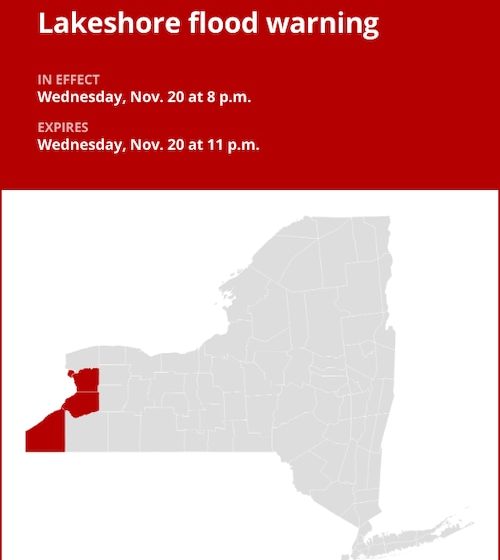The National Weather Service issued a lakeshore flood warning for Erie and Chautauqua counties on Wednesday at 7:52 p.m., which is in effect from 8 to 11 p.m.
According to the weather service, “Lakeshore flooding expected.”
“Lakeshore flooding will occur along the Lake Erie shoreline due to the extremely quick rise in water levels at the lake’s eastern edge. Route 5 in Hamburg, Buffalo Harbor and Canalside, Dunkirk Harbor, and other flood-prone areas are likely to experience flooding. Significant beach erosion will also be caused by extremely strong wave action, the weather agency says. “A lakeshore flood warning indicates that there is, will soon be, or is anticipated to be lakefront flooding. Avoid beaches, piers, rock outcroppings, and breakwaters for your own protection! Waves can quickly wash you away and are frequently bigger than they seem. Anticipate severe road closures in the area, substantial beach erosion and debris, and highly hazardous boating conditions.
Deciphering advisories, watches, and warnings: Understanding weather alerts
- Flash flood warning: Take action!
When a flash flood is approaching or already happening, a warning is sent. Get to high ground right away if you’re in a flood-prone location. A flash flood is a quick, intense flood that can form in a matter of minutes to hours. Even in places that don’t get rain right away, flash floods can happen.
- Flood warning: Take action!
When flooding is expected or is happening, a flood warning is issued.
- Flood advisory: Be aware:
When flooding is not predicted to become severe enough to warrant a warning, a flood advisory is issued. However, it still has the potential to be extremely inconvenient and, if careless, to result in circumstances that endanger life and/or property.
- Flood watch: Be prepared:
When the weather is conducive to flooding, a flood watch is issued. Flooding is not guaranteed, but it is a possibility.
Weathering the storm: Flood safety guidelines from the weather service
Knowing and adhering to the weather service’s flood safety recommendations can be extremely helpful when camping in low-lying areas or in places that are prone to flooding:
Look for higher ground.
If you’re in a flood-prone area, or if you’re camping in a low-lying spot, move to higher ground as a first step.
Observe evacuation directives:
Immediately comply with any evacuation orders issued by local authorities. Make sure your house is locked before you leave.
Cut off appliances and utilities:
Disconnect your appliances and utilities if you have the time. By taking this precaution, electrical dangers during flooding are reduced.
Avoid drowned places and flooding basements:
Avoid basements or rooms with electrical outlets or cords submerged in water. This lessens the chance of electrical mishaps.
Evacuate promptly for safety:
If you notice sparks or hear buzzing, crackling, snapping, or popping sounds, evacuate without delay. Do not enter water that may carry an electrical charge.
Refrain from walking in floodwaters:
Never attempt to walk through floodwaters, even if they appear shallow. Just 6 inches of fast-moving water can forcefully sweep you off your feet.
Seek high ground if trapped:
Should you become trapped by moving water, reach the highest point possible and dial 911 to contact emergency services.
During heavy rainfall, the risk of flooding is heightened, especially in low-lying and flood-prone regions. Always remember never to drive through water on the road, no matter how shallow it appears. According to the weather service, as little as 12 inches of rapidly flowing water can carry away most vehicles. Stay safe by being prepared and informed.
Advance Local Weather Alerts is a service provided by United Robots, which uses machine learning to compile the latest data from the National Weather Service.
Note: Every piece of content is rigorously reviewed by our team of experienced writers and editors to ensure its accuracy. Our writers use credible sources and adhere to strict fact-checking protocols to verify all claims and data before publication. If an error is identified, we promptly correct it and strive for transparency in all updates, feel free to reach out to us via email. We appreciate your trust and support!



Leave a Reply